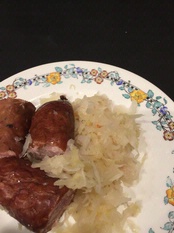WINE WITH…Sauerkraut and Polish Sausage
Some recipes are read simply for enjoyment, and often for the evocative pleasure of looking at another chapter in the history of cooking and dining. We were recently browsing through our ancient (1953) edition of
Bouquet de France: An Epicurean Tour of the French Provinces by Samuel Chamerlain, with recipes translated from the French and adapted by Narcissa Chamberlain. Many recipes were fun to read about even though we had no intention of ever making them: eggplant stuffed with anchovies, filet of beef with artichoke hearts and foie gras, caramelized bread pudding. A recipe for Choucroute Garnie in particular caught our eye, for we had a bag of

sauerkraut and some Polish smoked sausage in the refrigerator that we were planning to make for dinner that night.
Here’s how the Chamberlain choucroute recipe began:
“The first day melt down a good quantity of goose fat. Cover the bottom of a large earthen casserole with a layer of short ribs of beef.” Several other ingredients were then added, including Chablis, bacon, and smoked pork cutlets, and the mixture was simmered for 5 hours. “The next day,” the recipe continued, “add ½ bottle of Champagne and cook slowly for 3 to 4 hours. Cool. On the third day and great day…add ½ bottle of Champagne.” The dish was simmered another 4 hours, during which time a boned loin of pork and a variety of different sausages were added to the pot. “Then, 1 hour before presenting your masterpiece,” the recipe concluded, “add a few truffles.”
Here’s how we made our sauerkraut and sausage.
Sauerkraut and Polish Sausage
Serves 4
One 1-pound bag of sauerkraut 12 ounces smoked Polish sausage or Kielbasa 1 teaspoon juniper berries (optional) 1 cup white wine
Place the sauerkraut in a colander and rinse it lightly under cold, running water. Squeeze it dry and transfer to a large kettle. Cut the sausage in 1-2 inch pieces and add to the pot. Stir in the juniper berries if using, and pour in the wine. Cover the pot and simmer for 5 minutes, then uncover it and continue simmering for 5-10 minutes or until most of the liquid has been absorbed. The dish may be made ahead of time and reheated.
* * *
This is a tricky dish to partner with wine because its two ingredients are in many ways opposites. The sauerkraut tastes sharp and bracing, while the sausage is rich and satisfying. They dance with on your palate without ever fully embracing, and the wrong wine will disrupt the choreography. Tannin proves disruptive, which explains why white wines generally fare better than reds. You’ll want a wine with noticeable acidity (to stand up to the kraut), though we were pleasantly surprised by how well a fairly lush California Chardonnay worked with the dish. It made for a comfortable match, and this is comfort food at heart.